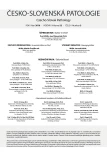-
Články
Top novinky
Reklama- Vzdělávání
- Časopisy
Top články
Nové číslo
- Témata
Top novinky
Reklama- Kongresy
- Videa
- Podcasty
Nové podcasty
Reklama- Kariéra
Doporučené pozice
Reklama- Praxe
Top novinky
ReklamaIntracardial fungal multiplication of order Mucor in an almost totally carbonised part of a male body found after ten days missing
Authors: Silvia Farkašová Iannaccone 1; Jaroslav Klán 2; Laura W. Lamps 3; Daniel Farkaš 4; Marián Švajdler ml. 5; Miroslav Szabo 4
Authors place of work: Bioptická laboratoř s. r. o., Plzeň a Oddelenie patológie, Univerzitná nemocnica Louisa Pasteura, Košice ; Ústav súdneho lekárstva UPJŠ LF, Košice 1; Ústav soudního lékařství a toxikologie 1. LF UK a VFN, Praha 2; Department of Pathology, University of Arkansas for Medical Sciences, Little Rock, AR 3; Úrad pre dohľad nad zdravotnou starostlivosťou, SLaPA pracovisko, Košice 4; Šiklův ústav patologie, Univerzita Karlova Praha, Lékařská fakulta Plzeň 5
Published in the journal: Soud Lék., 61, 2016, No. 3, p. 35-38
Category: Původní práce
Summary
Determination of time of death belongs to the most difficult and also the most important issues for the medical examiners, especially those who deal with violent death. Besides the most frequently evaluated postmortal changes it is sometimes possible to perform the evaluation on the basis of less frequently observed findings. One of such findings is for example the fungal multiplication on the body or in the very close vicinity. Knowledge of moulds as well as information about their speed of growth should contribute to confirmation or negation of some information gained during police investigation. In this case report authors describe the macroscopically visible fungal intracardiac multiplication in heart chambers and aorta in an almost totally carbonised body which was missing for only ten days. Based on the molecular examination it was detected that the body belonged to the 64-year-old man who was repeatedly hospitalised in psychiatry for depression with suicidal tendencies. The last hospitalisation was six weeks before death and there was no organic disability. The cause of fire was a naked flame. The cause of death was burn injury or asphyxia. The almost total carbonisation did not allow to perform toxicological investigation. By histological investigation we found the presence of wide long non-septate moulds growing in the heart muscle, which belonged to the order Mucor. Since there was no obvious inflammatory response, we suppose their growth started on the congealed blood after death.
Keywords:
time of death – forensic mycology – Mucor
Zdroje
1. Suláková H, Markvartová J, Beran M. Hmyz a mrtvý muž v bytě. Kazuistika. Soud Lek 2013; 58(1): 2-5.
2. Tesař J. Soudní lékařství (3 vyd). Praha: Avicenum; 1985 : 237.
3. Sidrim JJ, Moreira Filho RE, Cordeiro RA, Rocha MF, Caetano EP, Monteiro AJ, Brilhante RS. Fungal microbiota dynamics as a postmortem investigation tool: focus on Aspergillus, Penicillium and Candida species. J Appl Microbiol 2010; 108(5): 1751-1756.
4. Hitosugi M, Ishii K, Yaguchi T, Chigusa Y, Kurosu A, Kido M, Nagai T, Tokudome S. Fungi can be a useful forensic tool. Leg Med (Tokyo) 2006; 8(4): 240-242.
5. Ishii K, Hitosugi M, Kido M, Yaguchi T, Nishimura K, Hosoya T, Tokudome S. Analysis of fungi detected in human cadavers. Leg Med (Tokyo) 2006; 8(3): 188-190.
6. Hawksworth DL, Wiltshire PE. Forensic mycology: the use of fungi in criminal investigations. Forensic Sci Int. 2011; 206(1-3): 1-11.
7. van de Voorde H, van Dijck PJ. Determination of the time of death by fungal growth. Z Rechtsmed 1982; 89(2): 75-80.
8. Hawksworth DL. Final Report on Mycological Findings Associated with Operation Lynx. Report for Tayside Police, Dundee; 2009 : 1-5.
9. Bednář M, Fraňková V, Schindler J, Souček A, Vávra J. Lékařská mikrobiologie. Praha: Marvil; 1996 : 357.
10. Klán J. Co víme o houbách Praha: SPN; 1989 : 89.
11. Lamps LW, Lai KK, Milner DA Jr. Fungal infections of the gastrointestinal tract in the immunocompromised host: an update. Adv Anat Pathol 2014; 21(4): 217-227.
12. Guarner J, Brandt ME. Histopathologic diagnosis of fungal infections in the 21st century. Clin Microbiol Rev 2011; 24(2): 247-280.
13. Prayson AR. Neuropathology Elsevier Churchill Livingstone 2005 : 305-307.
14. Siu KL, Lee WH. A rare cause of intestinal perforation in an extreme low birth weight infant-gastrointestinal mucormycosis: a case report. J Perinatol 2004; 24(5): 319-321.
15. Byard RW. Unusual patterned skin lesions caused by postmortem fungal activity. Forensic Sci Med Pathol 2014; 10(4): 651-653.
Štítky
Patologie Soudní lékařství Toxikologie
Článek vyšel v časopiseSoudní lékařství

2016 Číslo 3-
Všechny články tohoto čísla
- Molekulární genetika a stanovení doby úmrtí
- Životné jubileum prvej dámy slovenského súdneho lekárstva
- Úmrtia v súvislosti s alkoholom – retrospektívna analýza z regiónu severného Slovenska
- Prof. MUDr. Josef Korbička, CSc. – smutná zpráva
- Intrakardiálne pomnoženie plesní rodu Mucor v takmer totálne uhorenom torze tela muža po 10 dňoch od jeho zmiznutia
- Pracovní den soudního lékařství a toxikologie
- IALM Intersocietal Symposium - P5 Medicine & Justice
- Soudní lékařství
- Archiv čísel
- Aktuální číslo
- Informace o časopisu
Nejčtenější v tomto čísle- Prof. MUDr. Josef Korbička, CSc. – smutná zpráva
- Molekulární genetika a stanovení doby úmrtí
- Intrakardiálne pomnoženie plesní rodu Mucor v takmer totálne uhorenom torze tela muža po 10 dňoch od jeho zmiznutia
- Úmrtia v súvislosti s alkoholom – retrospektívna analýza z regiónu severného Slovenska
Kurzy
Zvyšte si kvalifikaci online z pohodlí domova
Autoři: prof. MUDr. Vladimír Palička, CSc., Dr.h.c., doc. MUDr. Václav Vyskočil, Ph.D., MUDr. Petr Kasalický, CSc., MUDr. Jan Rosa, Ing. Pavel Havlík, Ing. Jan Adam, Hana Hejnová, DiS., Jana Křenková
Autoři: MUDr. Irena Krčmová, CSc.
Autoři: MDDr. Eleonóra Ivančová, PhD., MHA
Autoři: prof. MUDr. Eva Kubala Havrdová, DrSc.
Všechny kurzyPřihlášení#ADS_BOTTOM_SCRIPTS#Zapomenuté hesloZadejte e-mailovou adresu, se kterou jste vytvářel(a) účet, budou Vám na ni zaslány informace k nastavení nového hesla.
- Vzdělávání



